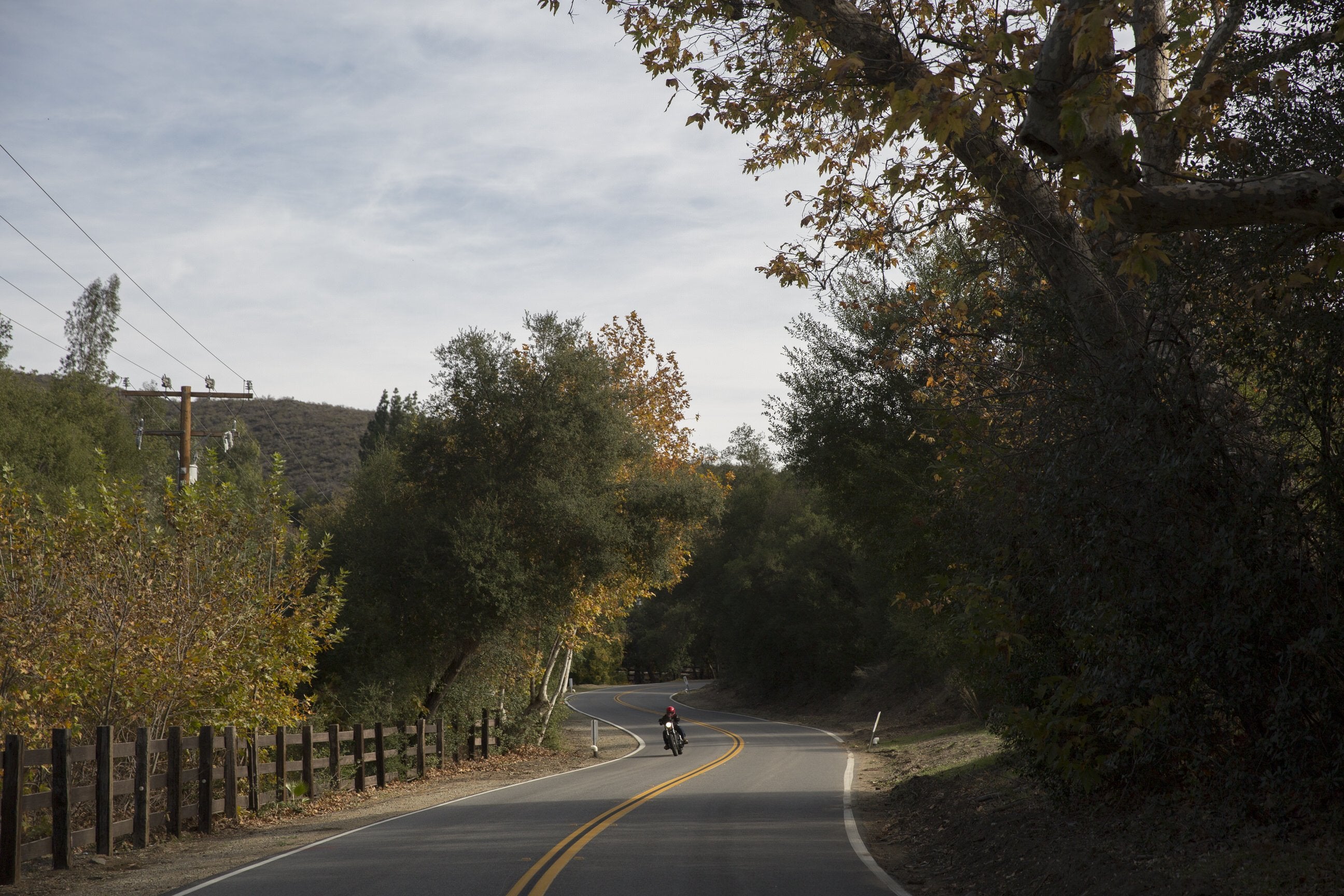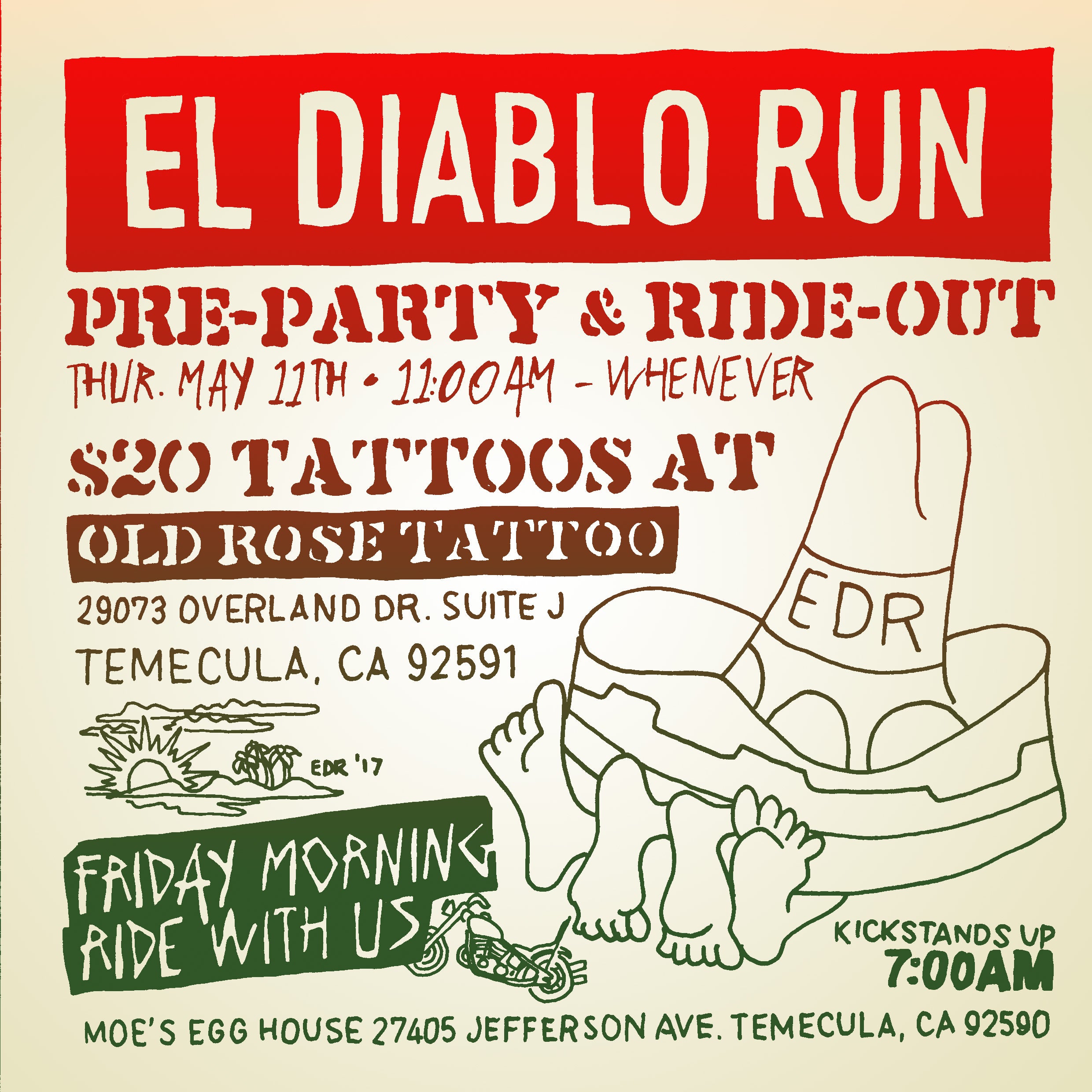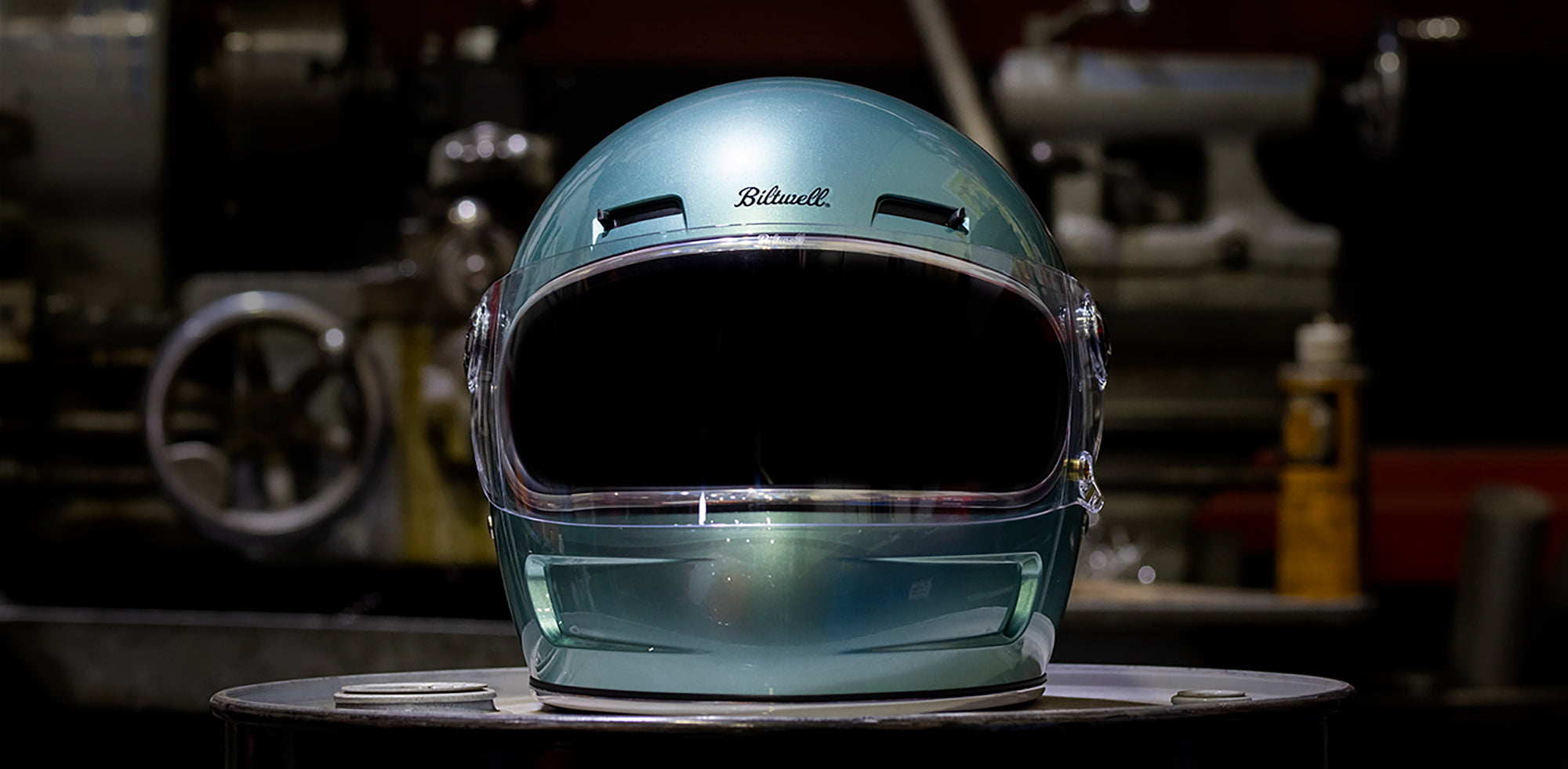Ergonomics is the science of man’s physical relationship to his work space. Prevailing wisdom holds that the more comfortably a person is situated at his desk, next to a machine, and yes, behind the handlebars on a motorcycle, the more safely and efficiently he will perform. We’re not brain scientists or rocket surgeons, but we do take ergonomics seriously, especially as it applies to handlebar design. Because we enjoy riding and modifying so many different kinds of motorcycles—everything from XR’s to chopped shovelheads—we’ve developed some time-tested theories on which motorcycle cockpit assemblies look and work best, and which ones are janky, dangerous or downright dumb.
 Our Slimline risers have been many home customers’ go-to bolt-on for over a decade. Their clean styling complements the swoopiness of this vintage H-D nacelle perfectly.
Our Slimline risers have been many home customers’ go-to bolt-on for over a decade. Their clean styling complements the swoopiness of this vintage H-D nacelle perfectly.
 A knucklehead about as perfect as they get. The apes/tall riser combo isn’t our cup of tea, however. Read the story to learn why.
This month’s DIY 101 addresses a conundrum that’s puzzled bike builders for ages: “Will these bars work on my bike?” We know this subject is a headscratcher because dozens of customers email us this question every month. The speedy salvation most people seek is only a Google search away. Here’s two for your enjoyment:
Alas, many people—this writer included—sometimes find the whole Google process tedious, and prefer to come to the source. Without further ado, here are some Biltwell handlebar/riser combinations we’ve used, as well as some tips, hits and misses for each assembly. Use this DIY 101 for inspiration to create your own bar/riser combo, or rip us off completely—we’ll be flattered either way.
Ah, the ubiquitous apehanger. Beloved or bemoaned by chopper cognoscenti on every side of the spectrum. Given my deep motocross and BMX roots pre-choppers, I must admit I hated apes early on—they put my hands too high, and the leverage they generated was counterintuitive (all upward, very little outward.) Then I rode a rigid chopper with a set of Biltwell Apes and I was a believer. The height is stylish without being uncomfortable, and the backsweep puts your hands in the right spot for all-day comfort.
Tips: We strongly recommend never running ape handlebars with tall risers. Reason: the added leverage of tall/wide apes can and will make tall risers (4” or more) flex too much where they mount on the top tree, especially if the tree features rubber isolators commonly found on Harley-Davidsons. We recommend our Gordo risers for Apes: they feature a larger clamp surface to hold bars tight, and their thru-bolt design works with triple trees and springer forks.
Hits: Apes looks best on big bikes: Shovels, pans, Evo choppers, etc.—the longer the better
Misses: Apes tend to look silly on short bikes: Sportsters, for instance, or old Triumphs. Japanese ROMs (regular old motorcycles) are also a no-no. Generally speaking, short wheelbases and tall handlebars don’t mix
We introduced the Breezer bar a few years ago because too many home customers were putting our Keystone bar on modern Dynas. The Keystone bar has minimal backsweep, so any bike longer than a Sportster forces the rider to reach too far forward, severely compromising ergonomics and comfort. The Breezer bar has the pointy look at the welded joints for chopper style, and enough backsweep to put your hands where they belong on any bike with a long backbone.
Tips: The Breezer isn’t a tall bar relatively speaking, but it does generate enough leverage that we recommend using our Thunder riser for added clamping power. The Thunder riser is a one-piece affair, so it will only fit on top trees with 3.5-inch (89mm) riser-mount bolt hole spacing.
Hits: Dynas; low-slung shovelheads in a stock swingarm or rigid frame
Misses: Metric cruisers; Classic Bonnevilles of any era; café racers; street trackers
We introduced our first handlebar and riser over a decade ago. Ten years hence Keystone and Slimline still remain a popular combo for an army of home and pro customers.
Tips: Our Keystone handlebar is “flat” in chopper parlance, meaning it has very little backsweep. To maintain sensible ergonomics, we recommend installing Keystone bars on bikes with short backbones and stock head angles. Doing otherwise puts the bar either too far forward or too back in your lap, neither of which is comfortable or stylish.
Hits: Stock and rigid Sportsters (excluding Street Tracker and Café styles); vintage rigid Triumphs (preferably unit era—pre-unit models look better unmolested in our opinion); XS650 choppers
Misses: Late-model Dynas; Shovel, pan or Evo choppers in stock chassis (backbone is generally too long)
With this bar/riser combo you have a cockpit that’s popular on an eclectic range of custom motorcycles: everything from stretched and raked choppers to lane-splitting Sportsters and practically any Japanese or British chopper with a hydraulic fork.
Tips: The taller the riser, the shorter the bar. The photo shows our Maynard bar (2” rise) with an 8-inch-tall Murdock riser. We assembled this combo for the first time on Otto’s GI Chopper, and it got rave reviews. That bike had a 10-over hydraulic fork on an aftermarket frame with stock angles. Mike’s 6-3, and the ergonomics were perfect.
Hits: Stretched and raked choppers with long forks; stock XL’s (stay below 8” on the riser, however)
Misses: Any bike with Wide Glide forks (too narrow compared to the width of the fork legs); late-model Dynas
This assembly has “Street tracker” written all over it, and for that reason many people love it. Nobody rides H-D Sporties harder than Mark “The Rusty Butcher” Atkins, and he swears by this handlebar. 4130 chromoly and hand TIG welding makes it strong, and perfect small-radius bends and just the right amount of rise and backsweep make it look correct, period.
Tips: Assembled with our Thunder riser this combo provides a rock-solid cockpit for any bike that’s likely to be ridden hard. We’ve also seen club-style Dynas with our Moto bar, but limited backsweep demands the rider be on the tall side.
Hits: Stock Sportsters; Japanese and British dirt trackers; almost any short-wheelbase motorcycle with a swingarm and stock head angle
Misses: Metric cruisers; anything with a long fork, or a frame that’s been raked or stretched
While the look is still just creeping into America’s heartland, club-style Dynas and modernized FXRs are everywhere on both coasts, especially in California. With six rises and two finishes available, our Murdock riser satisfies Harley customizers hungry for an alternative to the T-bar that defines this style. Our Tracker bar and its taller sibling the Tracker XL work perfectly to complete a cockpit that provides more choices and greater adjustability, never a bad thing.
Tips: Murdock risers look great on practically any Big Twin custom you can dream up, but the package depends on which bars you choose. Our Tracker and Tracker XL bars are wide for a reason: it takes muscle to control a full-sized, high-performance Harley at speed.
Also, these tall 12- and 14-inch tall Murdock risers generate a lot of torque at their mounting point in the top tree, which is why we provide two grade-8 ½-13 bolts for installation. Use thread prep or blue Loc-Tite and torque the mounting bolts to 25-30 ft. lb. (33.8–40.6 Nm) to ensure a safe, reliable finished assembly.
Hits: FXR’s; Dynas; Evo big twin choppers
Misses: As we mentioned with apes, bar/riser combos that are especially tall look awkward on short motorcycles. If you select the Murdock riser for your Sportster, for instance, we recommend the 6- or 8-inch rise on these machines
Sportsters deserve love too, which is why we offer our Murdock riser in 4-, 6-, 8-inch heights. Coupled with a simple bar like our Zero Drag, the look screams “narrow, tough and fast.” Several guys on the Biltwell crew rock this exact setup, and each man (and one woman) swears by it.
Tips: If you’re not running stock hand controls, consider cutting three-quarters to 1.5 inches off each side of the bar, especially on smaller bikes (Triumph choppers, rigid XL’s, etc.) The narrower profile looks tough on compact motorcycles, and doesn’t compromise comfort or leverage enough to cause a problem.
Hits: Rigid and swingarm Sportsters; old British choppers; chopped XS650s
Misses: Metric cruisers, H-D Big Twins
Summing Everything Up
When you offer as many different sizes and styles of handlebars and risers as we do, the choices can be overwhelming. We went the extra mile in these categories because freedom of choice is an essential tenant of the custom motorcycle credo. If you don’t see a combo that works for you in this feature, visit our website or do search the Googles—we guarantee you’ll find something. Also, please remember Form follows Function. Choose handlebars and risers that make your bike look cool without compromising comfort or handling. And if you have doubts about installing handlebars, click here.
A knucklehead about as perfect as they get. The apes/tall riser combo isn’t our cup of tea, however. Read the story to learn why.
This month’s DIY 101 addresses a conundrum that’s puzzled bike builders for ages: “Will these bars work on my bike?” We know this subject is a headscratcher because dozens of customers email us this question every month. The speedy salvation most people seek is only a Google search away. Here’s two for your enjoyment:
Alas, many people—this writer included—sometimes find the whole Google process tedious, and prefer to come to the source. Without further ado, here are some Biltwell handlebar/riser combinations we’ve used, as well as some tips, hits and misses for each assembly. Use this DIY 101 for inspiration to create your own bar/riser combo, or rip us off completely—we’ll be flattered either way.
Ah, the ubiquitous apehanger. Beloved or bemoaned by chopper cognoscenti on every side of the spectrum. Given my deep motocross and BMX roots pre-choppers, I must admit I hated apes early on—they put my hands too high, and the leverage they generated was counterintuitive (all upward, very little outward.) Then I rode a rigid chopper with a set of Biltwell Apes and I was a believer. The height is stylish without being uncomfortable, and the backsweep puts your hands in the right spot for all-day comfort.
Tips: We strongly recommend never running ape handlebars with tall risers. Reason: the added leverage of tall/wide apes can and will make tall risers (4” or more) flex too much where they mount on the top tree, especially if the tree features rubber isolators commonly found on Harley-Davidsons. We recommend our Gordo risers for Apes: they feature a larger clamp surface to hold bars tight, and their thru-bolt design works with triple trees and springer forks.
Hits: Apes looks best on big bikes: Shovels, pans, Evo choppers, etc.—the longer the better
Misses: Apes tend to look silly on short bikes: Sportsters, for instance, or old Triumphs. Japanese ROMs (regular old motorcycles) are also a no-no. Generally speaking, short wheelbases and tall handlebars don’t mix
We introduced the Breezer bar a few years ago because too many home customers were putting our Keystone bar on modern Dynas. The Keystone bar has minimal backsweep, so any bike longer than a Sportster forces the rider to reach too far forward, severely compromising ergonomics and comfort. The Breezer bar has the pointy look at the welded joints for chopper style, and enough backsweep to put your hands where they belong on any bike with a long backbone.
Tips: The Breezer isn’t a tall bar relatively speaking, but it does generate enough leverage that we recommend using our Thunder riser for added clamping power. The Thunder riser is a one-piece affair, so it will only fit on top trees with 3.5-inch (89mm) riser-mount bolt hole spacing.
Hits: Dynas; low-slung shovelheads in a stock swingarm or rigid frame
Misses: Metric cruisers; Classic Bonnevilles of any era; café racers; street trackers
We introduced our first handlebar and riser over a decade ago. Ten years hence Keystone and Slimline still remain a popular combo for an army of home and pro customers.
Tips: Our Keystone handlebar is “flat” in chopper parlance, meaning it has very little backsweep. To maintain sensible ergonomics, we recommend installing Keystone bars on bikes with short backbones and stock head angles. Doing otherwise puts the bar either too far forward or too back in your lap, neither of which is comfortable or stylish.
Hits: Stock and rigid Sportsters (excluding Street Tracker and Café styles); vintage rigid Triumphs (preferably unit era—pre-unit models look better unmolested in our opinion); XS650 choppers
Misses: Late-model Dynas; Shovel, pan or Evo choppers in stock chassis (backbone is generally too long)
With this bar/riser combo you have a cockpit that’s popular on an eclectic range of custom motorcycles: everything from stretched and raked choppers to lane-splitting Sportsters and practically any Japanese or British chopper with a hydraulic fork.
Tips: The taller the riser, the shorter the bar. The photo shows our Maynard bar (2” rise) with an 8-inch-tall Murdock riser. We assembled this combo for the first time on Otto’s GI Chopper, and it got rave reviews. That bike had a 10-over hydraulic fork on an aftermarket frame with stock angles. Mike’s 6-3, and the ergonomics were perfect.
Hits: Stretched and raked choppers with long forks; stock XL’s (stay below 8” on the riser, however)
Misses: Any bike with Wide Glide forks (too narrow compared to the width of the fork legs); late-model Dynas
This assembly has “Street tracker” written all over it, and for that reason many people love it. Nobody rides H-D Sporties harder than Mark “The Rusty Butcher” Atkins, and he swears by this handlebar. 4130 chromoly and hand TIG welding makes it strong, and perfect small-radius bends and just the right amount of rise and backsweep make it look correct, period.
Tips: Assembled with our Thunder riser this combo provides a rock-solid cockpit for any bike that’s likely to be ridden hard. We’ve also seen club-style Dynas with our Moto bar, but limited backsweep demands the rider be on the tall side.
Hits: Stock Sportsters; Japanese and British dirt trackers; almost any short-wheelbase motorcycle with a swingarm and stock head angle
Misses: Metric cruisers; anything with a long fork, or a frame that’s been raked or stretched
While the look is still just creeping into America’s heartland, club-style Dynas and modernized FXRs are everywhere on both coasts, especially in California. With six rises and two finishes available, our Murdock riser satisfies Harley customizers hungry for an alternative to the T-bar that defines this style. Our Tracker bar and its taller sibling the Tracker XL work perfectly to complete a cockpit that provides more choices and greater adjustability, never a bad thing.
Tips: Murdock risers look great on practically any Big Twin custom you can dream up, but the package depends on which bars you choose. Our Tracker and Tracker XL bars are wide for a reason: it takes muscle to control a full-sized, high-performance Harley at speed.
Also, these tall 12- and 14-inch tall Murdock risers generate a lot of torque at their mounting point in the top tree, which is why we provide two grade-8 ½-13 bolts for installation. Use thread prep or blue Loc-Tite and torque the mounting bolts to 25-30 ft. lb. (33.8–40.6 Nm) to ensure a safe, reliable finished assembly.
Hits: FXR’s; Dynas; Evo big twin choppers
Misses: As we mentioned with apes, bar/riser combos that are especially tall look awkward on short motorcycles. If you select the Murdock riser for your Sportster, for instance, we recommend the 6- or 8-inch rise on these machines
Sportsters deserve love too, which is why we offer our Murdock riser in 4-, 6-, 8-inch heights. Coupled with a simple bar like our Zero Drag, the look screams “narrow, tough and fast.” Several guys on the Biltwell crew rock this exact setup, and each man (and one woman) swears by it.
Tips: If you’re not running stock hand controls, consider cutting three-quarters to 1.5 inches off each side of the bar, especially on smaller bikes (Triumph choppers, rigid XL’s, etc.) The narrower profile looks tough on compact motorcycles, and doesn’t compromise comfort or leverage enough to cause a problem.
Hits: Rigid and swingarm Sportsters; old British choppers; chopped XS650s
Misses: Metric cruisers, H-D Big Twins
Summing Everything Up
When you offer as many different sizes and styles of handlebars and risers as we do, the choices can be overwhelming. We went the extra mile in these categories because freedom of choice is an essential tenant of the custom motorcycle credo. If you don’t see a combo that works for you in this feature, visit our website or do search the Googles—we guarantee you’ll find something. Also, please remember Form follows Function. Choose handlebars and risers that make your bike look cool without compromising comfort or handling. And if you have doubts about installing handlebars, click here.
 Our Slimline risers have been many home customers’ go-to bolt-on for over a decade. Their clean styling complements the swoopiness of this vintage H-D nacelle perfectly.
Our Slimline risers have been many home customers’ go-to bolt-on for over a decade. Their clean styling complements the swoopiness of this vintage H-D nacelle perfectly. A knucklehead about as perfect as they get. The apes/tall riser combo isn’t our cup of tea, however. Read the story to learn why.
A knucklehead about as perfect as they get. The apes/tall riser combo isn’t our cup of tea, however. Read the story to learn why. Odds & Ends
Odds & Ends Parts & Labor Expo
Parts & Labor Expo Biltwell 100
Biltwell 100 El Diablo Run
El Diablo Run People's Champ
People's Champ Helmet Auction
Helmet Auction Motofest
Motofest Kernville Kampout
Kernville Kampout WTF Blog
WTF Blog P&L Magazine
P&L Magazine P&L Podcast
P&L Podcast










